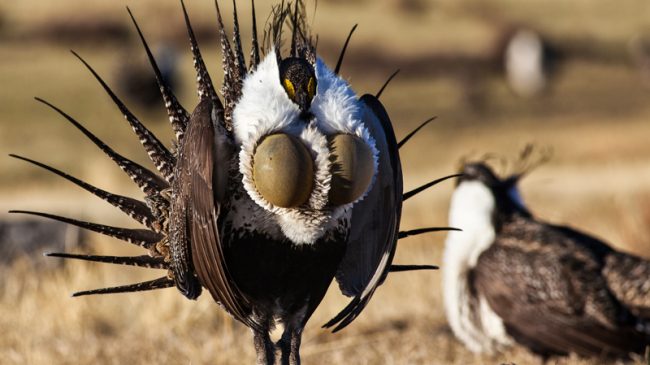There is a widespread narrative promoted by some environmental pressure groups and some in the federal government that the sage grouse needs protection under the Endangered Species Act because state and local conservation efforts are inadequate. Fortunately, there are a couple resources that effectively refute this, one of which is an online map (available here) of the 57 active local working groups that cover the sage grouse’s 165 million acre range across eleven states.
The breakdown of the working groups is: California, 2 groups (both shared with Nevada because sage grouse live along the border of the two states); Colorado, 11, (one shared with Utah); Idaho, 10; Montana, 4; Nevada, 5 (2 shared with California); North Dakota, 1; Oregon, 5; South Dakota, 1; Utah, 12 (1 shared with Colorado); Washington, 1; and Wyoming, 8.
The combination of the large number of groups and their geographic extent also provides a stark illustration of the seriousness with which states and municipalities across the sage grouse’s range are taking conservation of the bird, including efforts to keep it off the endangered species list. For example, virtually all of Wyoming, much of Nevada, and over half of Utah are covered by working groups, and many of the other eight states have enormous portions of land encompassed by working groups.
The online map of the working groups is also a very useful tool because people using it can “click” on a state and access a web page that has further information and links to that state’s working groups. Then, by clicking on each working group a separate web page appears with useful information on each group, such as the year it was formed, contact information for key people involved, the land area encompassed by the group and an acreage breakdown of land ownership, and links to associated documents.
Another related key resource that effectively refutes the pro-listing narrative is the Public Lands Council’s Sage Grouse Conservation Library, which has a wealth of information, including all of the state and local conservation plans (which are available here). As with the map, a list of these plans provides a sense of the seriousness of states’ commitments to sage grouse conservation.
- California: plan for the greater sage grouse population in eastern California and western Nevada, 2004, with appendices; two regional plans, 2006 and 2010; and a plan for the Bi-state greater sage grouse population in east-central California and west-central Nevada, 2012.
- Colorado: statewide plan for the greater sage grouse, 2008, supplemented and updated in 2013; five regional plans for the greater sage grouse, 1999-2008; rangewide plan for the Gunnison sage grouse subspecies (co-authored with Utah), 2005; and six regional plans for the Gunnison sage grouse, 1997-2011.
- Idaho: statewide plan, 2006, with appendices; a portion of the plan was revised in 2009.
- Montana: statewide plan, 2005.
- Nevada: plan for sage grouse population in western Nevada and eastern California, 2004, with appendices; a strategic statewide plan, 2012; the State of Nevada Alternative plan, 2012; and the plan for the Bi-state population of the greater sage grouse along the Nevada-California border, 2012.
- Oregon: statewide plan, 2011.
- South Dakota: statewide plan, 2008.
- Utah: statewide plan for greater sage grouse, 2009, updated in 2013; rangewide plan for the Gunnison sage grouse (co-authored with Colorado), 2005.
- Washington: statewide plan, 2004.
The combination of the map of local working groups and all of the state and regional conservation plans paints a picture that is in stark contrast to, and much more accurate than, that painted by those in favor of listing the sage grouse under the Endangered Species Act. So the next time you hear someone saying the sage grouse needs to be listed under the Act because state and local efforts are insufficient, let them know about the map of local working groups and the Sage Grouse Conservation Library’s collection of conservation plans.
